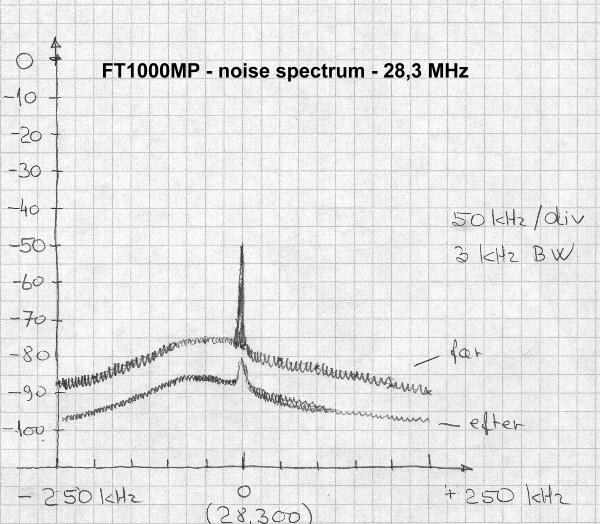Background:
Transmitter broadband noise can be the source of interference when working close in frequency to very strong stations. It manifest itself by increased noise level in your receiver, whenever the other station is keying their transmitter (-they don't have to modulate). I have measured a number of popular transceivers.
Measuring setup:
Connect the transmitter to a spectrum analyzer through a suitable attenuator or coupler. A signal level of approx. 1 mW to the analyzer is fine.Now key the transmitter and adjust the analyzer to a sweep of about 50 kHz/div with a RF resolution of about 3 kHz. It's important that the bandwidth corresponds to SSB bandwidth - it makes interpretation of the results much easier. (Reviews in magasines often uses noise in 1Hz bandwidth, which gives a 34dB too optimistic picture)
Adjust the attenuator of the spectrum analyzer so that full PEP output corresponds to top of the screen.
What you see now, is the full modulated signal from the transmitter,
together with the noise level - some 60 to 70 dB down - from
the analyzer. The dynamic range of a standard analyzer is not capable
of revealing sideband noise from a "decent" transmitter.
But there is a trick. By not (SSB) modulating the keyed transmitter
(turn the mike gain down) -
the peak of the signal will drop 40 - 50 dB from the top of the
screen (depends of carrier suppression and LF amplifier noise).
This now makes it possible to increase the gain of the analyzer by
the same amount: With this increased sensitivity we can now suddenly
see the broadband noise from the transmitter - even when it's
100 - 110 dB down!
Finally to check whether it's really the transmitter noise we're measuring, just turn off the transmitter and you should hopefully see the noise on the screen drop down to the analyzers own noise floor.

The YAESU FT 225 2 meter all band transceiver shows a very low level of noise around the TX frequency of 144,200 MHz.

This is another YAESU FT 225, with the same kind of performance.

The ICOM IC 202 2 meter SSB transceiver is often regarded as a benchmark among transmitters with clean, low noise signals. The measurement was limited by analyzer noise, so the transceivers own noise is lower.

The Kenwood TS 120 is a rather old HF-transceiver, that we (OZ9KY) use to drive our 432 MHz transverter. The spectrum is taken on 28,2 MHz. Measurement on 432 MHz - with 25 W output from the trransverter shows about 1 dB more noise. The X-tal oscillator chain in the transverter does not contribute significantly to the overall noise level.

This Kenwood TS 930 HF-transceiver was used to drive a 144 MHz transverter (through the transverter output connection). However as can be seen the noise level (measured on 144,2 MHz) is rather high and not in the -90 to -100 dB range we want. The noise level was originally 10 dB higher, but after carefully adjustment of drive level to the transverter we reached the 80 dB. This shows that any degree of overdriving will increases the broadband noise.

This YAESU FT 990 has a severe problem with broad band noise! Don't use it in VHF/UHF contest's unless you're at least 200 km away from "civilisation". The transverter was driven from the normal HF output connector, with power control turned all the way down. This certainly contributes to the high noise level.

As a top notch HF transceiver it's dissapointing to see the YAESU FT
1000MP having such a bad noise spectrum on 28,3 MHz. It's actually worse
than the average transceiver 20 years ago.
The two curves shows the noise level at 2,5W (-used when driving a 144 MHz
transverter) and 25 W output, with the higher
output having the better noise level. The reason must be the way power
regulation is done at some intermediate stage, where signal to noise
ratio is insufficient. Solution when driving transverters: - use the
dedicated transverter output to improve the signal/noise level or run
the transceiver at high power and use attenuators to give the 1W or less
that the transverter needs.

The YAESU FT-107M has very low sideband noise on it's transverter output. This is about as good as they get.

The Kenwood TS-820 also shows low noise level.